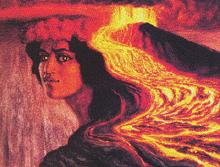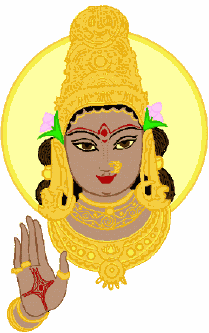Introduction to Goddess Spirituality

In most ‘traditional religions’ the supreme or only deity is male. But what we are now learning is that our most ancient traditions are traditions in which both men and women worshiped a Great Mother, a Great Goddess who was the mother of both divine daughters and divine sons.
Riane Eisler, “Reclaiming Our Goddess Heritage”
Long ago, some 20,000 years ago and more, the image of a goddess appeared across a vast expanse of land stretching from the Pyrenees to Lake Baikal in Siberia. Statues in stone, bone and ivory, tiny figures with long bodies and falling breasts, rounded motherly figures pregnant with birth, figures with signs scratched upon them — lines, triangles, zigzags, circles, nets, leaves, spirals, holes — graceful figures rising out of rock and painted with red ocher — all these have survived through the unrecorded generations of human beings who compose the history of the race.
Anne Baring and Jules Cashford, The Myth of the Goddess
Evidence of the omnipresence of Goddess worship in ancient times is both sketchy and overwhelming. Recent archaeological discoveries and improved dating techniques have led some scholars to theorize about an era when the Goddess was worshiped as the primary deity, the Source of all life, the Creator. Before the appearance of the warlike, male-dominated, hierarchical societies whose rise apparently coincided with the development of written language, these largely feminist scholars insist, our early forebears worshiped the cosmic Source of the universe and all life as female. Ancient figurines of broad-hipped women with prominent breasts and small heads or no faces, like the so-called “Willendorf Venus,” have been turning up by the thousands in archaeological digs. They are no longer viewed as mere fertility symbols or the fevered expression of primitive male imagination — “an ancient analogue for today’s Playboy magazine,” as one scholar put it — but as loving depictions of the Mother Goddess as the great life-giver.

At the same time, there is virtually no written record of the beliefs and practices of Goddess culture these archaologists and scholars propose, and so many conventional scholars of religion tend to write off the idea of an idyllic Goddess culture in which men and women shared power and warfare was virtually unknown as mere speculation. And yet, all those figurines, and the virulence with which the proponents of male warrior gods attacked the worship of the Goddess point to a once prevalent culture that was largely driven underground. From sometime in the Paleolithic, or Old Stone, Age, which ended around 10,000 years ago, the Goddess seems to have been universally worshiped from Southern Europe to Siberia, around the Mediterranean rim and down to the Fertile Crescent of Mesopotamia. She took on manifestations as the crane, duck, goose, dove, and owl, as well as the bull, bear, doe, butterfly, and bee. She was identified with life-giving waters in the form of rain or rivers, with vegetation, and with the moon, whose cycles determined the lunar calendar essential to agriculture.
Because the rise of the patriarchal religions coincided with the discovery and spread of written language and the technology with which to preserve written records, we have long had the impression that religion began with Yahweh, Ra, Mithra, Shiva, and other omnipotent male figures. Indeed, we have no idea what the Goddess may have been called in the earliest cultures, which left no decipherable written records. With the advent of writing in about the 4th millennium BCE, she was called Inanna, Ishtar, Astarte, or Asherah in the Fertile Crescent; Isis in Egypt; Gaia, Artemis, Aphrodite, Demeter, and Hera in Greece; Cybele in Anatolia and Rome.
As the Great Mother, the Goddess originally embodied both male and female characteristics. Those little figurines with the swelling hips often have long, phallic necks. But around 10,000 years ago separate phallic figures began to appear, often in the form of a serpent or bull. Human male figures also appear, occasionally in tandem with the Goddess, in what is referred to as the sacred marriage. Male gods first appear in Egyptian and Mesopotamian culture as the son and/or lover of the Goddess, but not yet as the dominant creator god of later times.
The cultures that produced these artifacts would have been characterized by matrilineal descent, with a high degree of importance and esteem accorded to women as the obvious life-givers, without whom humanity could not exist. The roles of the sexes most likely would have been balanced in a way that they have not been since. The art that survives from that era does not depict war between humans; weapons are shown being used solely in the hunt, and there are no archaeological signs of military fortifications, nor any indication of great discrepancies in wealth, rank, and status. The sacred and the secular would have been intimately interconnected and their social structure, egalitarian and communal rather than authoritarian and hierarchical. The arts flourished then; by all indications, they were largely developed during this long, peaceful summer following the last Ice Age — in all likelihood, by women.
Next – Invasion of the Nomad Hordes »


